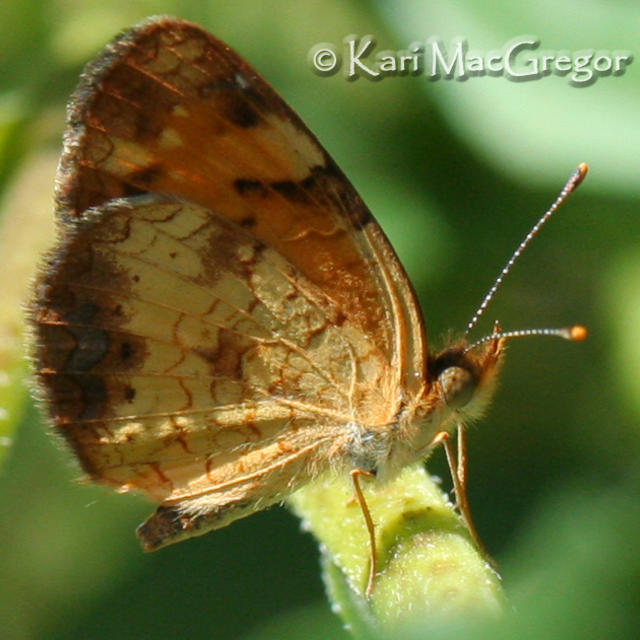Pearl Crescent
Phyciodes tharos (Drury, 1773)
Family: Nymphalidae
Subfamily: Nymphalinae
Identification: Quite variable. Males usually have black antennal knobs. Upperside is orange with black borders; postmedian and submarginal areas are crossed by fine black marks. Underside of hindwing has a dark marginal patch containing a light-colored crescent. Spring and fall broods (form marcia) have a gray mottled hindwing below.
Wing Span: 1 1/4 - 1 3/4 inches (3.2 - 4.5 cm).
Life History: Males patrol open areas for females. Eggs are laid in small batches on underside of host plant leaves. Caterpillars eat leaves and are gregarious when young. Hibernation is by third-stage caterpillars.
Flight: Several broods; from April-November in the north, throughout the year in the Deep South and Mexico.
Caterpillar Hosts: Several species of smooth-leaved true asters including Aster pilosus, A. texanus, and A. laevis.
Adult Food: Nectar from a great variety of flowers including dogbane, swamp milkweed, shepherd's needle, asters, and winter cress.
Habitat: Open areas such as pastures, road edges, vacant lots, fields, open pine woods.
Range: Southeastern Alberta south through Montana, Wyoming, Colorado, New Mexico, Arizona, and southeastern California to Mexico; east to southern Ontario and all the eastern United States.
Conservation: Not usually required.
NCGR: G5 - Demonstrably secure globally, though it may be quite rare in parts of its range, especially at the periphery.
Management Needs: None reported.
Get your BAMONA Gear!
Please donate!
We depend on donations to keep Butterflies and Moths of North America freely available. We want to express our gratitude to all who showed their support by making a contribution this year. You can donate to support this project at any time.
Advertise with us!
Do you have a product or service that you think would interest BAMONA users? If you would like to advertise on this website, contact us by email, or use the contact form and select the "Advertising" category.
Verified Sightings
Displaying 1 - 24 of 14535 verified sightings

Observation date: Sep 05, 2024
Submitted by: BKeener
Region: Gallatin County, Montana, United States
Verified by: J_Martineau
Verified date: Nov 04, 2024

Observation date: Nov 01, 2024
Submitted by: jmgesell
Region: Northampton County, Pennsylvania, United States
Verified by: davidwright
Verified date: Nov 03, 2024

Observation date: Sep 26, 2024
Submitted by: mathgeek
Region: Jackson County, Illinois, United States
Verified by: rogerdowner
Verified date: Oct 31, 2024

Observation date: Oct 07, 2024
Submitted by: Mulberry
Region: Grand County, Utah, United States
Verified by: James Steen
Verified date: Oct 29, 2024

Observation date: Oct 14, 2024
Submitted by: Sheilabean
Region: Texas, Tarrant County, United States
Verified by: jwileyrains
Verified date: Oct 15, 2024

Observation date: Oct 14, 2024
Submitted by: Sheilabean
Region: Texas, Tarrant County, United States
Verified by: jwileyrains
Verified date: Oct 15, 2024

Observation date: Oct 14, 2024
Submitted by: Sheilabean
Region: Texas, Tarrant County, United States
Verified by: jwileyrains
Verified date: Oct 14, 2024

Observation date: Sep 05, 2024
Submitted by: Mike L
Region: Erie County, Pennsylvania, United States
Verified by: davidwright
Verified date: Oct 14, 2024

Observation date: Oct 10, 2024
Submitted by: Alison Davies
Region: Lexington County, South Carolina, United States
Verified by: Dennis Forsythe
Verified date: Oct 11, 2024

Observation date: Oct 03, 2024
Submitted by: naj.pilla
Region: White County, Indiana, United States
Verified by: jmgesell
Verified date: Oct 04, 2024

Observation date: Sep 11, 2024
Submitted by: Cactuswren1976
Region: Santa Fe County, New Mexico, United States
Verified by: stevecary
Verified date: Sep 29, 2024

Observation date: May 26, 2023
Submitted by: dvollmar
Region: Wakulla County, Florida, United States
Verified by: John Calhoun
Verified date: Sep 23, 2024

Observation date: Sep 01, 2024
Submitted by: KABerry
Region: Clinton County, Pennsylvania, United States
Verified by: davidwright
Verified date: Sep 23, 2024

Observation date: Sep 16, 2024
Submitted by: Kentonky41015
Region: Kenton County, Kentucky, United States
Verified by: CA Ivy
Verified date: Sep 18, 2024

Observation date: Sep 15, 2024
Submitted by: NikkiM
Region: Carbon County, Montana, United States
Verified by: J_Martineau
Verified date: Sep 17, 2024

Observation date: Aug 25, 2024
Submitted by: mtobin11
Region: DuPage County, Illinois, United States
Verified by: rogerdowner
Verified date: Sep 15, 2024

Observation date: Sep 10, 2024
Submitted by: mtobin11
Region: Lake County, Illinois, United States
Verified by: rogerdowner
Verified date: Sep 14, 2024

Observation date: Aug 18, 2024
Submitted by: ButtahflyEtn37354
Region: Monroe County, Tennessee, United States
Verified by: James Steen
Verified date: Sep 03, 2024

Observation date: Aug 18, 2024
Submitted by: ButtahflyEtn37354
Region: Monroe County, Tennessee, United States
Verified by: James Steen
Verified date: Sep 03, 2024

Observation date: Sep 03, 2024
Submitted by: Alison Davies
Region: Lexington County, South Carolina, United States
Verified by: Dennis Forsythe
Verified date: Sep 03, 2024

Observation date: Sep 02, 2024
Submitted by: maryjanzen
Region: Centre County, Pennsylvania, United States
Verified by: davidwright
Verified date: Sep 03, 2024

Observation date: Aug 29, 2024
Submitted by: Lydiaak
Region: Allegheny County, Pennsylvania, United States
Verified by: davidwright
Verified date: Aug 31, 2024

Observation date: Aug 29, 2024
Submitted by: regina rochefort
Region: Barnstable County, Massachusetts, United States
Verified by: jwileyrains
Verified date: Aug 29, 2024

Observation date: Aug 19, 2024
Submitted by: mikeminium
Region: Rush County, Indiana, United States
Verified by: jmgesell
Verified date: Aug 20, 2024
- 1 of 606
- next ›


















